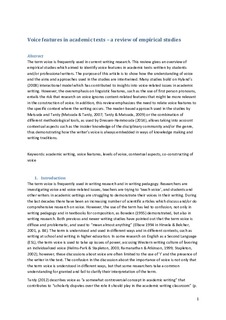| dc.contributor.author | Stock, Ingrid | |
| dc.contributor.author | Eik-Nes, Nancy Lea | |
| dc.date.accessioned | 2018-02-09T10:30:05Z | |
| dc.date.available | 2018-02-09T10:30:05Z | |
| dc.date.created | 2016-02-11T14:46:14Z | |
| dc.date.issued | 2016 | |
| dc.identifier.citation | Journal of English for Academic Purposes. 2016, 24, 89-99. | nb_NO |
| dc.identifier.issn | 1475-1585 | |
| dc.identifier.uri | http://hdl.handle.net/11250/2483688 | |
| dc.description.abstract | The term voice is frequently used in current writing research. This review gives an overview of empirical studies which aimed to identify voice features in academic texts written by students and/or professional writers. The purpose of this article is to show how the understanding of voice and the aims and approaches used in the studies are intertwined. Many studies build on Hyland’s (2008) interactional model which has contributed to insights into voice-related issues in academic writing. However, the overemphasis on linguistic features, such as the use of first person pronouns, entails the risk that research on voice ignores content-related features that might be more relevant in the construction of voice. In addition, this review emphasizes the need to relate voice features to the specific context where the writing occurs. The reader-based approach used in the studies by Matsuda and Tardy (Matsuda & Tardy, 2007; Tardy & Matsuda, 2009) or the combination of different methodological tools, as used by Dressen-Hammouda (2014), allows taking into account contextual aspects such as the insider knowledge of the disciplinary community and/or the genre, thus demonstrating how the writer's voice is always embedded in ways of knowledge making and writing traditions. | nb_NO |
| dc.language.iso | eng | nb_NO |
| dc.publisher | Elsevier | nb_NO |
| dc.rights | Attribution-NonCommercial-NoDerivatives 4.0 Internasjonal | * |
| dc.rights.uri | http://creativecommons.org/licenses/by-nc-nd/4.0/deed.no | * |
| dc.title | Voice features in academic texts – A review of empirical studies | nb_NO |
| dc.type | Journal article | nb_NO |
| dc.type | Peer reviewed | nb_NO |
| dc.description.version | acceptedVersion | nb_NO |
| dc.source.pagenumber | 89-99 | nb_NO |
| dc.source.volume | 24 | nb_NO |
| dc.source.journal | Journal of English for Academic Purposes | nb_NO |
| dc.identifier.doi | 10.1016/j.jeap.2015.12.006 | |
| dc.identifier.cristin | 1335011 | |
| dc.description.localcode | © 2016 Elsevier Ltd. All rights reserved. This is the authors' accepted and refereed manuscript to the article. | nb_NO |
| cristin.unitcode | 194,62,60,0 | |
| cristin.unitname | Institutt for språk og litteratur | |
| cristin.ispublished | true | |
| cristin.fulltext | postprint | |
| cristin.qualitycode | 2 | |

